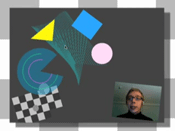Jeremy Bailey is a video and performance artist whose work is often confidently self-depricating in offering hilarious parodies of new media vocabularies. In his Video Terraform Dance Party (2008), Bailey plays an enthusiastic nerd channeling Bob Ross as he dons a forehead-mounted VR controller to demonstrate a new modeling software that will allow him to bop his head around and "plan the ideal landscape." As he narrates, his bespectacled eyes rise and fall at the horizon of a CGI world (outlined by vague computer icons and a $100 sign) and his movements trigger topographic changes in the blobby green island growing before him. The piece trades on two themes common in Bailey's work: the infomercial and a kind of ridiculously subtle (or perhaps not-so-subtle) implosion of metaphors about the use of the body in video-based performance art. The artist translates these well-worn themes into his performance of the anything-goes chaos of dot-com era product demos in SOS (2008), a video that cheerleads a brand new operating system (with a "bold new interface!") of the same name. Designed by Bailey, SOS bids farewell to the world's most popular software platforms and says hello to artist-created masterpieces--inspiring viewers to wonder which is truly "better." In describing the unusual look of the interface, Bailey's deadpan character says, "We're artists, so we thought, let's do it visually." So the "canvas" usurps the "desktop" and "your computer is a painting and your files and folders have been replaced by shapes and colors" which fit into three categories: rectangles show you things, circles analyze things, and triangles edit things. (Clearly this is much more intuitive than Windows!) When Bailey finally manages to get the program to open a file, we see a clip of the artist carrying out what can only be described as a quintessentially clichéd parody of scatalogical performance, after which the circle analyzes the video and tells him that he is pathetic. Bailey's response? Sometimes computers tell us things we don't want to hear...It's a new world and "we've just got to get used to this." In the artist's next project, Your Ad Here, he'll be transmitting messages some people do want to hear...He's turning his body into a billboard and offering advertisers a spot on the scrolling virtual LEDs on his head and plasma gun-shaped arms (of course there's a demo--the caption: "This sh*t is real time ballers, mf'ing real time"), for broadcast on Toronto subway platform screens during the Toronto Urban Film Festival. Leave it to Bailey to take the human billboard trope to the next game level! More of his spot-on projects can be seen on his YouTube channel. You'll want to see his Transhuman Dance Recital (2007) in which he "freed [him]self of the imitative constraints of the natural world" in order to dance around like an octopus with a triangle-shaped buddy. - Marisa Olson
Image: Jeremy Bailey, SOS, 2008